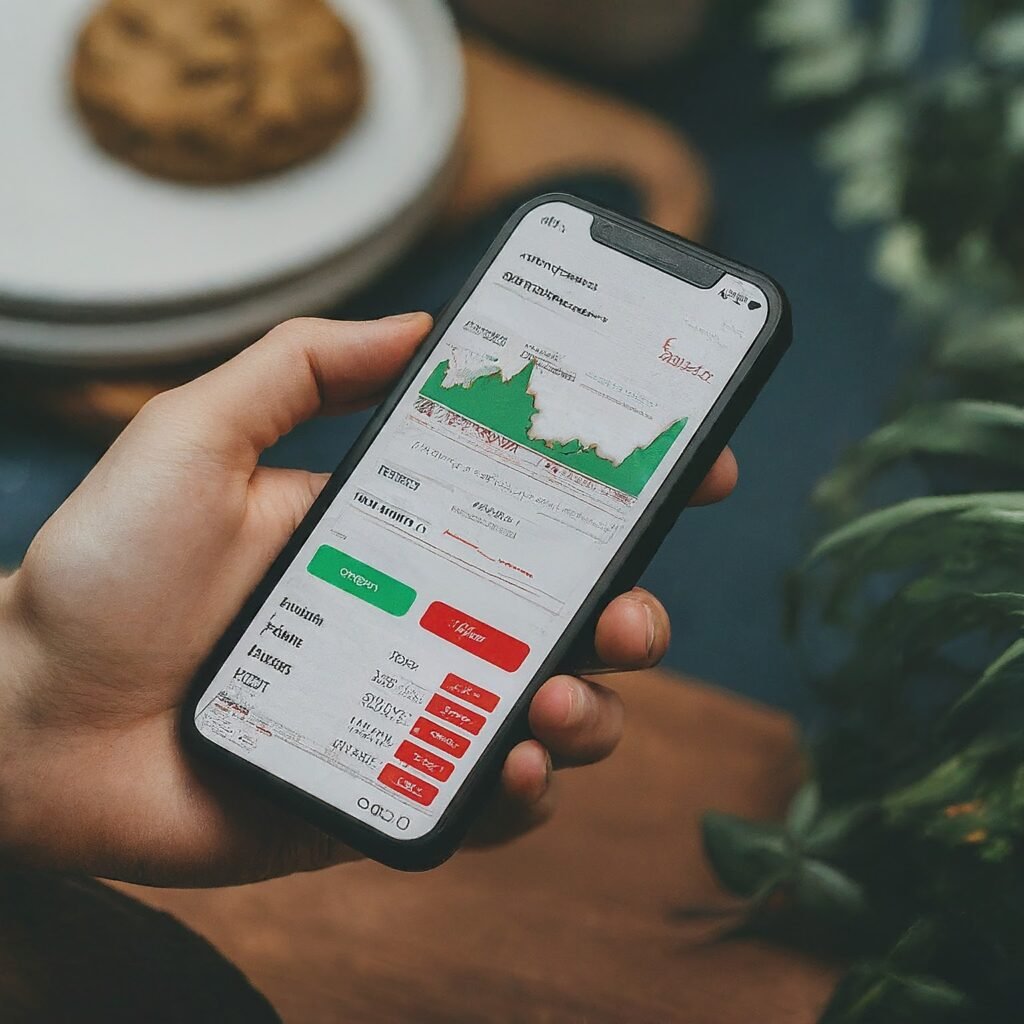Introduction
Have you ever wondered if AI trading can help you make money? Well, in this article, we will explore the potential benefits of AI trading and how it can potentially make a positive impact on your financial endeavors.
Discover how this technology is revolutionizing the world of trading, providing investors with intelligent tools to make informed decisions and potentially boost their profits.
So, grab a cup of coffee, and let’s delve into the exciting world of AI trading!
What is AI Trading?
Definition
AI trading, also known as algorithmic trading or automated trading, is the use of artificial intelligence technologies to make investment decisions and execute trades in financial markets. It involves the use of complex algorithms and powerful computing systems to analyze vast amounts of data and make trading decisions without human intervention.
How it works
AI trading systems are designed to process and analyze large volumes of data in real time, including market prices, news articles, economic indicators, and social media sentiment. These systems use advanced mathematical models and algorithms to identify patterns, trends, and opportunities in the market. Based on this analysis, AI trading systems can automatically execute trades, manage positions, and adjust investment strategies.
Advantages of AI Trading
Processing power and speed
One of the key advantages of AI trading is the ability to process and analyze vast amounts of data at a speed that is simply impossible for a human trader. AI trading systems can process and analyze thousands of data points in the blink of an eye, allowing for faster and more accurate decision-making. This speed and processing power give AI traders a significant advantage in identifying and capitalizing on market opportunities.
Emotionless decision-making
AI trading systems are not influenced by human emotions, such as fear or greed, which can often cloud judgment and lead to poor investment decisions. By eliminating emotional biases from the decision-making process, AI trading systems can make objective, data-driven decisions based on predefined rules and algorithms. This can lead to more consistent and disciplined trading strategies, resulting in improved performance over the long term.
Round-the-clock trading
AI trading systems can operate 24/7 without the need for breaks or sleep. They can continuously monitor the market, analyze data, and execute trades, even when the human trader is not available. This round-the-clock trading capability allows AI traders to take advantage of global market opportunities and react to market events in real time, providing a significant advantage over human traders who are limited by their physical and mental limitations.
Data-driven analysis
AI trading systems are designed to analyze and interpret vast amounts of historical and real-time data to identify patterns and trends. This data-driven analysis allows AI traders to make informed trading decisions based on empirical evidence, rather than relying on intuition or gut feelings.
By leveraging the power of big data and advanced analytics, AI trading systems can uncover hidden opportunities and generate more accurate predictions, enhancing the overall profitability of trading strategies.

Disadvantages of AI Trading
Complex algorithms
The algorithms used in AI trading systems can be highly complex and require specialized knowledge and expertise to develop and maintain. Designing effective algorithms involves understanding advanced mathematical concepts, statistical models, and financial theories. Additionally, updating and refining these algorithms to adapt to changing market conditions can be a challenging and time-consuming process. Therefore, AI trading may not be suitable for individuals without a strong technical background or access to skilled professionals.
Technical failures
AI trading systems rely on sophisticated technology infrastructure to collect, process, and execute trades. This dependence on technology introduces the risk of technical failures, such as system crashes, network outages, or data errors. These technical failures can disrupt trading operations, lead to financial losses, and erode trust in the reliability of AI trading systems. AI traders must implement robust risk management protocols and backup systems to mitigate the impact of technical failures.
Lack of human intuition
While AI trading excels in processing large volumes of data and identifying patterns, it lacks the human intuition and subjective judgment that can be crucial in certain market conditions. Human traders can bring valuable insights and intuition based on experience, intuition, and understanding of market dynamics that may not be easily quantifiable or captured by AI trading systems. Therefore, it is essential to strike a balance between AI-driven decision-making and human intervention to optimize trading outcomes.
Market unpredictability
Financial markets are inherently unpredictable, and AI trading systems are not immune to market volatility and unexpected events. Sudden shifts in market sentiment, geopolitical developments, or economic shocks can lead to rapid price changes and market disruptions. While AI trading systems are designed to adapt to changing market conditions, there is always a risk of unforeseen circumstances that can challenge the effectiveness of AI trading strategies. It is important for AI traders to continuously monitor and evaluate the performance of their algorithms and make necessary adjustments when needed.
Success Stories of AI Trading
Quantitative hedge funds
Quantitative hedge funds, which heavily rely on AI trading strategies, have achieved significant success in recent years. These funds, managed by investment professionals and data scientists, utilize AI algorithms to analyze vast amounts of financial data and identify profitable trading opportunities. By combining the power of AI technology with human expertise, these funds have outperformed traditional hedge funds and generated substantial returns for their investors.
Improved accuracy in trading
AI trading has revolutionized the accuracy and precision of trading decisions. By analyzing historical data and learning from past market patterns, AI trading systems can identify trading signals with high levels of accuracy.
This enhanced accuracy reduces the risk of making costly mistakes and enhances the overall profitability of trading strategies. Many institutional investors and professional traders have adopted AI trading systems to gain a competitive edge in the market.
Reduced market inefficiencies
AI trading has also contributed to the reduction of market inefficiencies. By quickly analyzing large amounts of market data and reacting to information in real time, AI trading systems can exploit price discrepancies and arbitrage opportunities that would be difficult for human traders to identify.
This increased efficiency in market operations benefits not only AI traders but also the overall functioning of financial markets by promoting fairer and more transparent pricing mechanisms.

Risks and Challenges of AI Trading
Overfitting and curve-fitting
One of the key risks in AI trading is overfitting and curve-fitting of trading strategies. Overfitting occurs when a trading algorithm is excessively optimized for historical data, resulting in a strategy that performs well in the past but fails to generalize to future market conditions. Curve-fitting is the process of tweaking the parameters and rules of a trading strategy to fit historical data closely, leading to the illusion of profitability. To mitigate these risks, AI traders should carefully validate their algorithms using out-of-sample data and adopt robust risk management techniques.
Data reliability
The accuracy and reliability of the data used by AI trading systems are crucial to the effectiveness of their strategies. Inaccurate or incomplete data can lead to flawed analysis and erroneous trading decisions. Therefore, AI traders must ensure the quality and integrity of the data they feed into their algorithms. This involves data cleansing, preprocessing, and regular validation to minimize the impact of data inaccuracies on the performance of AI trading systems.
Regulatory concerns
The rise of AI trading has attracted increased scrutiny and regulatory attention. Regulators are concerned about the potential risks associated with AI trading, including market manipulation, insider trading, and systemic risks. As a result, there is a growing need for appropriate regulations and oversight to ensure the responsible and ethical use of AI trading systems. AI traders must stay informed about existing and evolving regulations to ensure compliance and mitigate legal and reputational risks.
Types of AI Trading Strategies
Trend following
Trend-following strategies involve identifying and capitalizing on price trends in the market. AI trading systems can analyze historical price data and detect patterns that indicate the direction and strength of trends. By automatically executing trades based on these trend signals, AI traders can profit from the momentum of price movements.
Mean reversion
Mean reversion strategies aim to capitalize on the tendency of prices to revert to their average levels after deviating from them. AI trading systems can analyze price data and identify situations where prices have become overextended relative to their average values. By executing trades that anticipate the reversal of price movements, AI traders can profit from mean reversion opportunities.
Arbitrage
Arbitrage strategies involve taking advantage of price discrepancies between different markets or assets. AI trading systems can quickly analyze multiple markets and execute trades that exploit price differences. The speed and efficiency of AI trading systems make them well-suited for identifying and capitalizing on arbitrage opportunities that may exist only for a brief period.
Market-making
Market-making strategies involve providing liquidity to the market by continuously quoting bid and ask prices. AI trading systems can automatically monitor market conditions, analyze order flow, and adjust bid-ask spreads to ensure smooth market operations. By acting as market makers, AI traders can profit from the bid-ask spread and earn transaction fees while minimizing their exposure to market risks.
News-based
News-based trading strategies involve analyzing news articles, social media sentiment, and other sources of real-time information to predict market reactions. AI trading systems can process and interpret textual data using natural language processing technologies and sentiment analysis algorithms. By reacting quickly to news events, AI traders can profit from price movements driven by market sentiment.
Pattern recognition
Pattern recognition strategies involve identifying and capitalizing on recurring chart patterns or technical indicators. AI trading systems can analyze historical price data and detect patterns such as triangles, flags, or moving average crossovers. By automatically executing trades based on these pattern signals, AI traders can profit from price movements driven by technical factors.
Choosing an AI Trading Platform

Robust technology infrastructure
When choosing an AI trading platform, it is essential to consider the technology infrastructure that supports the platform. The platform should have a reliable and secure network, high-speed data feeds, and powerful computing capabilities. A robust technology infrastructure ensures that AI trading systems can operate seamlessly without significant downtime or performance issues.
Accuracy and track record
The accuracy and track record of an AI trading platform are crucial indicators of its reliability and effectiveness. It is important to assess the platform’s historical performance and evaluate its ability to generate consistent profits over time. Additionally, consider the platform’s reputation and client testimonials to gauge its credibility and trustworthiness.
Transparent and interpretable decisions
AI trading systems should provide transparency and interpretability in their decision-making process. It is important to understand how the platform generates trading signals, what data it uses, and how it evaluates market conditions. Transparent decision-making allows traders to validate the reasoning behind trading decisions and make informed judgments about the effectiveness of the AI trading platform.
Customizability and flexibility
Different traders have unique preferences and trading styles. Therefore, it is important to choose an AI trading platform that offers customizability and flexibility. The platform should allow traders to adjust and fine-tune trading strategies to align with their risk tolerance and investment objectives. Additionally, consider the ease of use and user-friendliness of the platform’s interface to ensure a smooth trading experience.
Cost considerations
The cost of using an AI trading platform is an important factor to consider. Evaluate the pricing structure of the platform, including upfront fees, ongoing subscription costs, and transaction fees. Consider the value provided by the platform relative to its cost and ensure that the potential benefits outweigh the expenses associated with using the platform.
Steps to Get Started with AI Trading
Educate yourself on AI trading
Before getting started with AI trading, it is important to educate yourself on the principles, concepts, and techniques involved in AI trading. Familiarize yourself with the mathematical models, statistical methods, and programming languages commonly used in AI trading. Understanding the fundamentals of AI trading will help you make informed decisions and optimize the performance of your AI trading strategies.
Choose a reliable platform or software
Selecting a reliable AI trading platform or software is crucial to your success as an AI trader. Conduct thorough research and due diligence to identify platforms that have a proven track record, robust technology infrastructure, and positive user reviews. Consider factors such as the platform’s features, compatibility with your trading style, and customer support capabilities.
Research and backtest strategies
Once you have chosen an AI trading platform, start researching and developing trading strategies that align with your investment goals and risk appetite. Test and backtest these strategies using historical data to evaluate their performance and refine their parameters. Backtesting allows you to simulate the performance of your trading strategies under different market conditions and helps identify strengths and weaknesses.
Start with small investments
When starting with AI trading, it is advisable to begin with small investments and gradually increase your exposure as you gain experience and confidence. This approach allows you to understand the dynamics of AI trading and assess the performance of your strategies with limited financial risk. As you gain proficiency and achieve consistent profitability, you can consider scaling up your investments.
Evaluate and adapt
Evaluating and adapting your AI trading strategies is an ongoing process. Continuously monitor the performance of your strategies and analyze the impact of market conditions on their effectiveness. Identify areas for improvement and make necessary adjustments to capitalize on emerging opportunities and mitigate risks. Regularly review your trading strategies to ensure they remain aligned with your investment goals and risk tolerance.
Impact of AI Trading on Financial Markets

Increased trading volume and liquidity
AI trading has significantly contributed to increased trading volume and liquidity in financial markets. The speed and efficiency of AI trading systems enable high-frequency trading and facilitate the execution of a large number of trades within short time frames. This increased trading activity enhances market liquidity, making it easier for investors to enter and exit positions at favorable prices.
Reduced market inefficiencies
AI trading has also contributed to the reduction of market inefficiencies. By quickly analyzing vast amounts of market data and reacting to information in real time, AI trading systems can exploit price discrepancies and arbitrage opportunities. These actions lead to more efficient market operations and the elimination of pricing anomalies that can be exploited by human traders.
Structural changes in job roles
The rise of AI trading has brought about structural changes in the job roles within the financial industry. Traditional roles, such as manual execution traders and market analysts, are being replaced by AI trading systems. However, new roles are emerging, such as AI strategists, data scientists, and algorithm developers, who are responsible for designing, implementing, and optimizing AI trading strategies. These new roles require expertise in AI technologies and data analysis, reflecting the evolving nature of the financial industry.

Conclusion
The potential of AI trading to revolutionize financial markets is immense. With its processing power, speed, and data-driven analysis, AI trading systems provide significant advantages over traditional trading methods.
However, AI trading also comes with its own set of challenges and risks, including complex algorithms, technical failures, and market unpredictability. By understanding the advantages and disadvantages of AI trading and adopting responsible trading practices, individual traders can harness the power of AI to enhance their trading strategies and potentially achieve consistent profitability.
Frequently Asked Questions
Source Links
Can you make money from AI trading?
Yes, AI trading can be profitable. It involves using algorithms and artificial intelligence to analyze data, make predictions, and execute trades. Many investors and institutions have found success by incorporating AI into their trading strategies 1.
Is AI stock trading profitable?
AI stock trading can be profitable, especially when applied over the long term. AI algorithms can process vast amounts of historical data, identify patterns, and make informed decisions. However, like any investment strategy, there are risks involved, and results may vary 1.
Can I use AI to make me money?
Absolutely! AI can assist you in making investment decisions. Whether you’re a self-directed investor or using robo-advisors, AI tools can help optimize your portfolio, manage risk, and provide personalized advice 2.
How accurate is AI trading?
The accuracy of AI trading depends on the quality of data, the sophistication of algorithms, and the specific use case. While AI can process large datasets and identify patterns, it’s essential to continuously monitor and refine the models 2.
Can you trust AI trading?
Trusting AI trading involves understanding its limitations and risks. While AI can enhance decision-making, it’s essential to combine it with human judgment and stay informed about market dynamics 3.
Can AI replace forex traders?
AI can automate certain tasks in forex trading, such as data analysis and execution. However, human expertise remains crucial for interpreting geopolitical events, market sentiment, and adapting to unforeseen circumstances 4.
What are the disadvantages of AI trading?
Some disadvantages include overreliance on historical data, susceptibility to unexpected market shifts, and the potential for algorithmic errors. Additionally, AI models may not account for extreme events or black swan events 2.
Can AI predict the forex market?
AI can make predictions based on historical data, technical indicators, and market trends. However, predicting the forex market accurately remains challenging due to various external factors and global events 2.
How to trade forex using AI?
To trade forex using AI, start by researching and understanding AI tools. Consider using platforms that offer AI-driven insights, backtesting capabilities, and risk management features. Always combine AI with your own analysis and risk management strategies 2.
How do I start AI trading?
Begin by learning about AI tools, understanding market dynamics, and experimenting with paper trading or virtual portfolios. Explore robo-advisors, stock screeners, and automated portfolio builders to get started 2.
Can you make money with automated Forex trading?
Automated Forex trading, powered by AI algorithms, can be profitable. However, it’s essential to choose reliable platforms, set risk parameters, and continuously monitor performance 2.
Which AI bot is best for trading?
There are several AI bots available, each with its strengths. Research popular ones like QuantConnect, MetaTrader, and AlgoTrader to find the best fit for your trading style and goals 2.
How much does AI Trader cost?
The cost of AI trading platforms varies. Some offer free versions with limited features, while others charge subscription fees. Research different platforms to find one that aligns with your budget and needs 2.
Can you use AI for day trading?
Yes, AI can be used for day trading. It can analyze real-time data, execute trades, and manage risk efficiently. However, day traders should combine AI with their expertise and adaptability 2.
Which AI trading platform is best for beginners?
For beginners, user-friendly platforms like Wealthfront, Betterment, and ZACKS (NASDAQ) are excellent choices. These robo-advisors simplify the investment process and incorporate AI-driven strategies 2.
- Analyst Answers Data & Finance for Work & Life: AI Trading: Success Rates & Profitability.
- Investopedia: How to Use Artificial Intelligence in Your Portfolio in 2024.
- BBC: Could AI ‘trading bots’ transform the world of investing?
- The Conversation: Humans v AI: here’s who’s better at making money in financial markets.
- NASDAQ: Make Money With AI: 7 Ways It Can Improve Your Investing.






